Key Takeaways:
- The United States, Egypt, and Qatar are pushing a new, multi-part plan to end the Israel-Hamas war. The US-Egyptian-Qatari plan will enable Hamas to reconstitute and present a continued threat to Israel. This proposed plan, as reported, does not include any provisions to disarm Hamas.
- Israeli forces raided an underground tunnel in a civilian area of Khan Younis that previously held Israeli hostages.
- Palestinian militias conducted five indirect fire attacks targeting southern Israel on January 21.
- Palestinian fighters clashed with Israeli forces in four locations across the West Bank on January 20 after CTP-ISW’s data cutoff.
- Lebanese Hezbollah (LH) conducted four attacks from southern Lebanon into northern Israel targeting Israeli towns and military facilities on January 21.
- The Islamic Resistance in Iraq claimed responsibility for two one-way drone attacks targeting US positions in Syria on January 21.
The United States, Egypt, and Qatar are pushing a new, multi-part plan to end the Israel-Hamas war.[i] The plan contains three parts that will occur over a 90-day period, according to the Wall Street Journal. Hamas would first release all civilian hostages in return for Israel releasing “hundreds” of Palestinian prisoners. Israel would also withdraw its forces from population centers in the Gaza Strip, allow freedom of movement throughout the Gaza Strip, end “surveillance,” and double the flow of humanitarian aid into the strip. Hamas would release all female Israeli soldiers and return the bodies of dead hostages to Israel in the second stage. Finally, Hamas would release the remaining Israeli soldiers and fighting-age males, while Israeli forces withdraw from the strip completely. An Egyptian official told the Wall Street Journal that the parties to the agreement are considering “safety guarantees” for Hamas’ political leadership and the formation of an “international fund” for the reconstruction of the Gaza Strip. After the 90-day period, the plan would lead to a permanent ceasefire in the Gaza Strip, the normalization of relations between Israel and Saudi Arabia, and the relaunching of a process to form a Palestinian state.
Israeli Prime Minister Benjamin Netanyahu reiterated his rejection of a “ceasefire” in exchange for the release of all Israeli hostages held by Hamas in a video published on January 21.[ii] Netanyahu was not explicitly responding to the US-Egyptian-Qatari plan. Netanyahu noted that an end to the war that leaves Hamas intact means that the next October 7 attack is “a matter of time.” Netanyahu laid out the Israeli war aims—”deradicalization” of Palestinian society, demilitarization of the Gaza Strip, and the destruction of Hamas—in the Wall Street Journal on December 25, 2023.[iii]
The US-Egyptian-Qatari plan will enable Hamas to reconstitute and present a continued threat to Israel. This proposed plan, as reported, does not include any provisions to disarm Hamas. Hamas will be able to rebuild its governance capabilities in the Gaza Strip, which allowed it to generate funds for its operations prior to its October 7 attack.[iv] Hamas would essentially have access to the same resource pools that it had prior to the war. Hamas fighters are already reinfiltrating areas that Israeli forces cleared in the northern Gaza Strip, which will facilitate Hamas’ reconstitution.[v] This reinfiltration process would accelerate under the implementation of the first phase of the proposed plan, in which Israeli forces would leave Gazan cities and towns.[vi] “Safety guarantees” for Hamas’ political leadership would protect some of the planners of the October 7 attacks, possibly including Yahya Sinwar. Sinwar is Hamas’ political leader in the Gaza Strip. He closely collaborates with Hamas military leaders Mohammad Deif and Marwan Issa.[vii] Sinwar also founded and led Hamas’ internal security apparatus and is responsible for the deaths of many Palestinians and Israelis in that role.[viii]
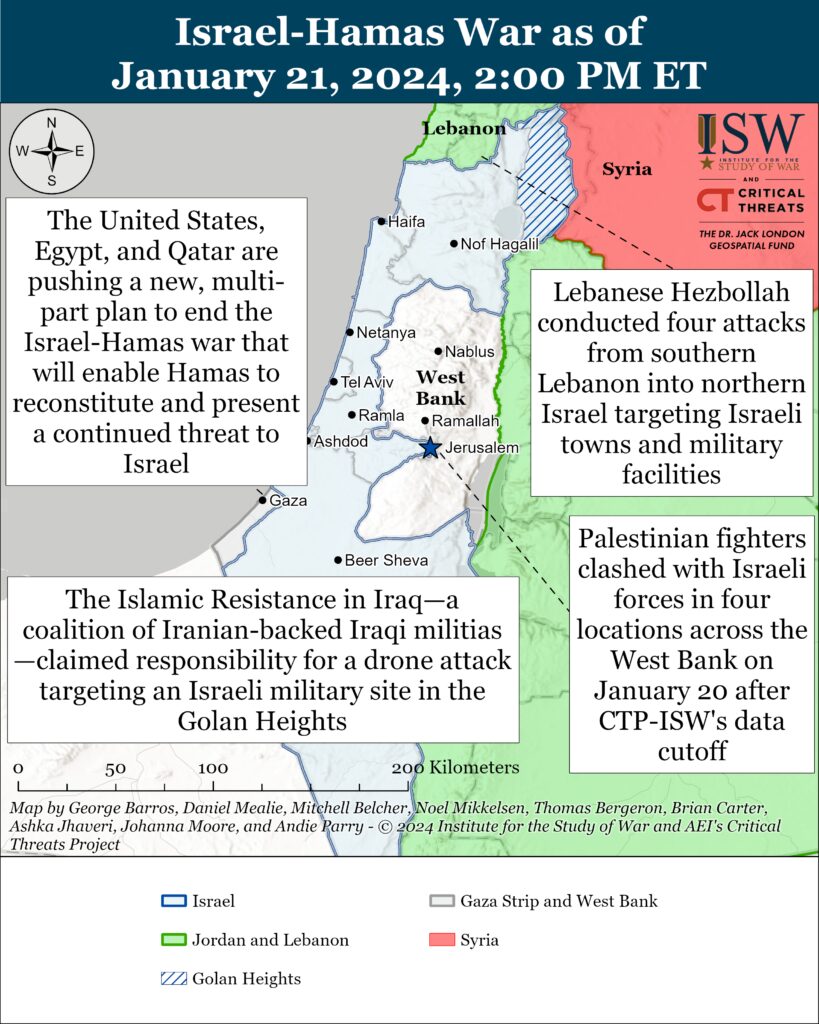
Gaza Strip
Axis of Resistance campaign objectives:
Erode the will of the Israeli political establishment and public to launch and sustain a major ground operation into the Gaza Strip
Degrade IDF material and morale around the Gaza Strip.Israeli forces raided an underground tunnel in a civilian area of Khan Younis that previously held Israeli hostages.[ix] Palestinian fighters moved the hostages prior to the tunnel’s capture by Israeli forces. The IDF said that the tunnel entrance was inside the home of a Hamas fighter. Palestinian fighters placed boobytraps inside the tunnel and posted guards outside the tunnel. The IDF killed the guards to make entry into the tunnel system. Israeli forces discovered five prison cells where Hamas kept the hostages. Israeli forces also captured Hamas intelligence documents and weapons inside the tunnel. The IDF said that there were 20 hostages held in the tunnel system at a time, according to unspecified testimonies. The IDF said that Hamas held some of the hostages who it released in the November 2023 exchange deal inside this tunnel.[x] The IDF published children’s drawings as proof the hostages had been held there. Israeli media reported that the drawings belonged to five-year-old Emilia Aloni, one of the hostages freed in November 2023.[xi] The IDF destroyed the tunnel after IDF forces searched it.
The Yiftach Brigade (assigned to the 99th Division) conducted clearing operations in Maghazi in the central Gaza Strip.[xii] Yiftach Brigade armor and engineers destroyed a Hamas weapons factory and a rocket launch site in Maghazi camp.[xiii] Palestinian fighters fired rocket-propelled grenades at the brigade during the operation. The IDF said that the brigade killed over 30 Palestinian fighters during the engagement.[xiv] The military wing of Palestinian Islamic Jihad (PIJ), the al Quds Brigades, conducted indirect fire attacks on Israeli armor and infantry advancing north from Bureij, roughly a kilometer north of Maghazi.[xv] Al Quds Brigades ”snipers” fired at Israeli forces northeast of Bureij camp.[xvi]
Palestinian militias claimed attacks targeting Israeli forces in Jabalia on January 21. The al Qassem Brigades—the military wing of Hamas—fired anti-tank munitions at Israeli armor in Jabalia City. The al Aqsa Martyrs Brigades—the self-proclaimed militant wing of Fatah—and the National Resistance Brigades—the military wing of the Democratic Front for the Liberation of Palestine (DFLP)—claimed that it clashed with Israeli dismounted infantry east of Jabalia refugee camp.[xvii] The National Resistance Brigades also fired thermobaric rockets at Israeli infantry.[xviii]
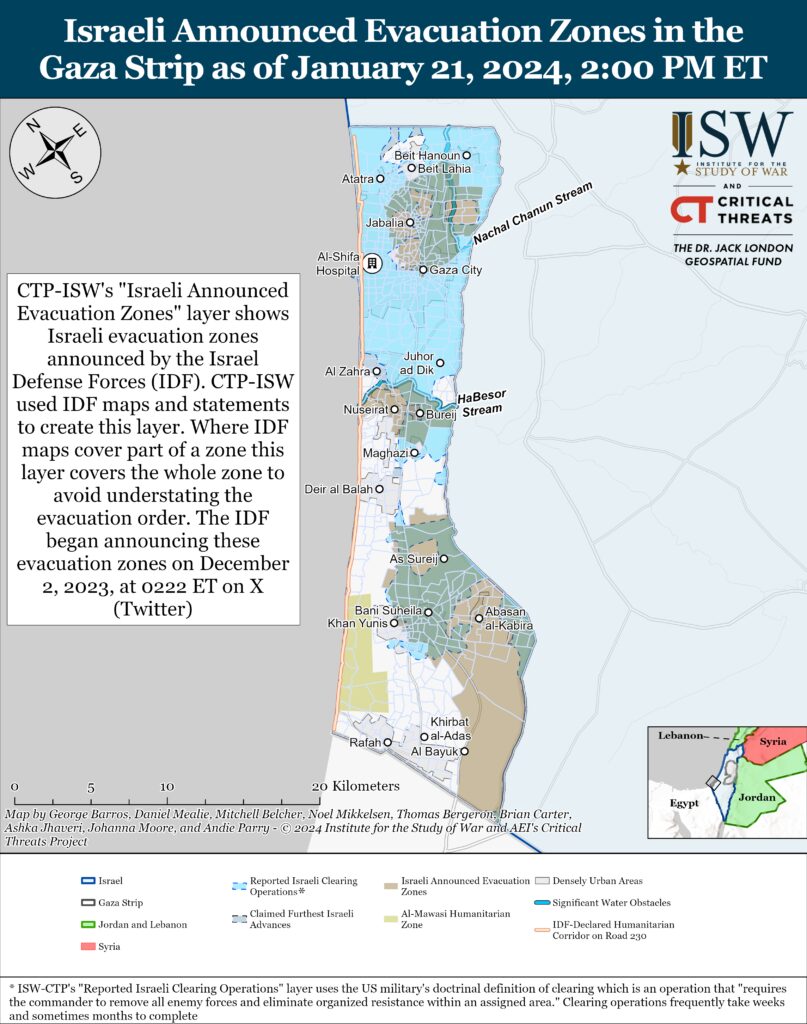
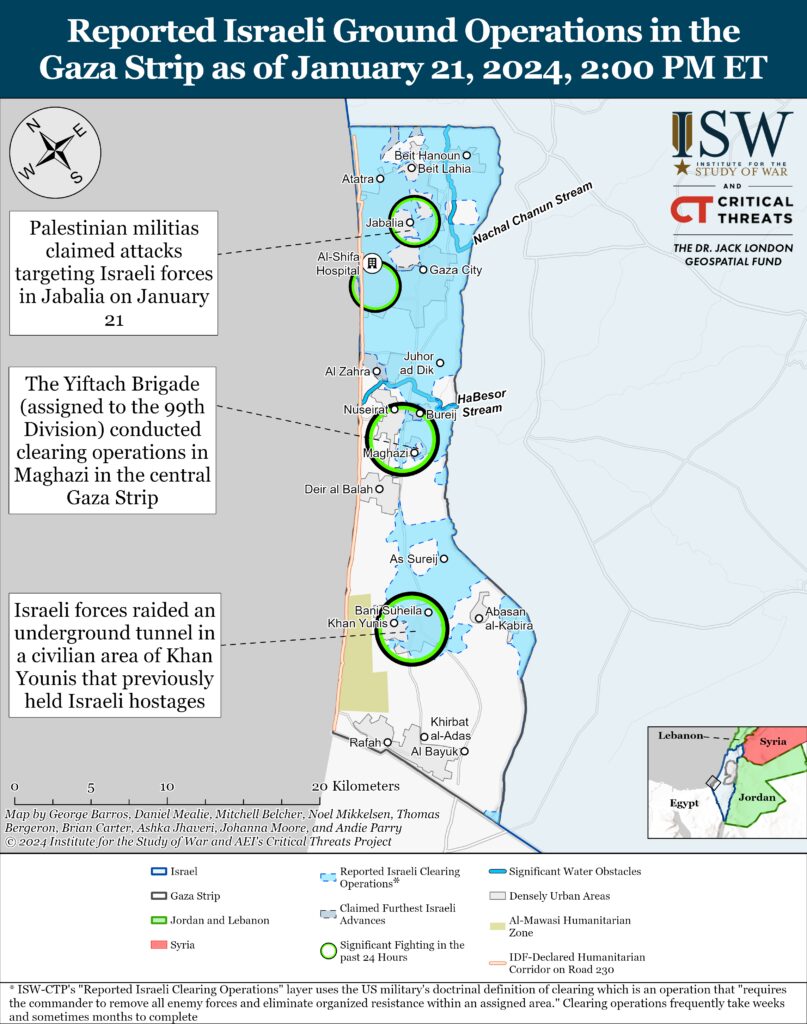
Palestinian militias conducted five indirect fire attacks targeting southern Israel on January 21. This is the largest number of indirect fire attacks into Israel since January 7.[xix] Three Palestinian militias mortared Israeli armor at the Sufa military site near the southern tip of the Gaza Strip.[xx] The al Aqsa Martyrs Brigades and the military wing of the Palestinian Mujahideen Movement, the Mujahideen Brigades, launched rockets at Nahal Oz in a combined operation on January 21.[xxi] The al Quds Brigades launched rockets at Kissufim.[xxii]
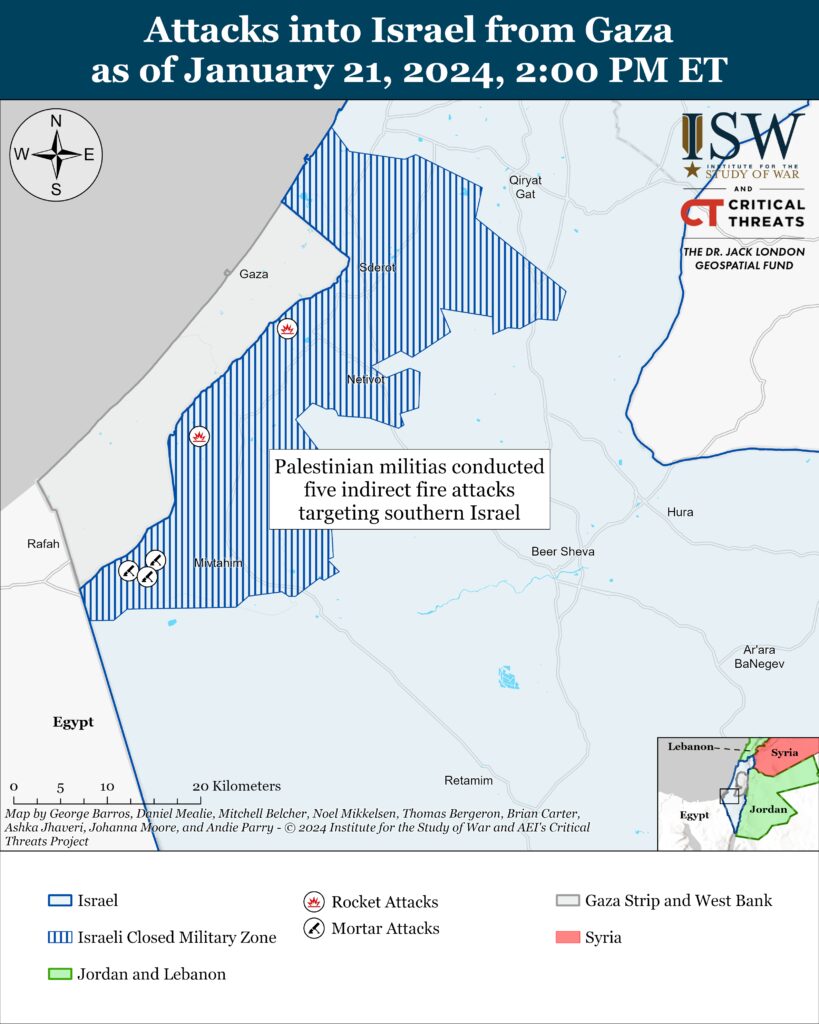
West Bank
Axis of Resistance campaign objectives:
Draw IDF assets and resources toward the West Bank and fix them therePalestinian fighters clashed with Israeli forces in four locations across the West Bank on January 20 after CTP-ISW’s data cutoff.[xxiii]
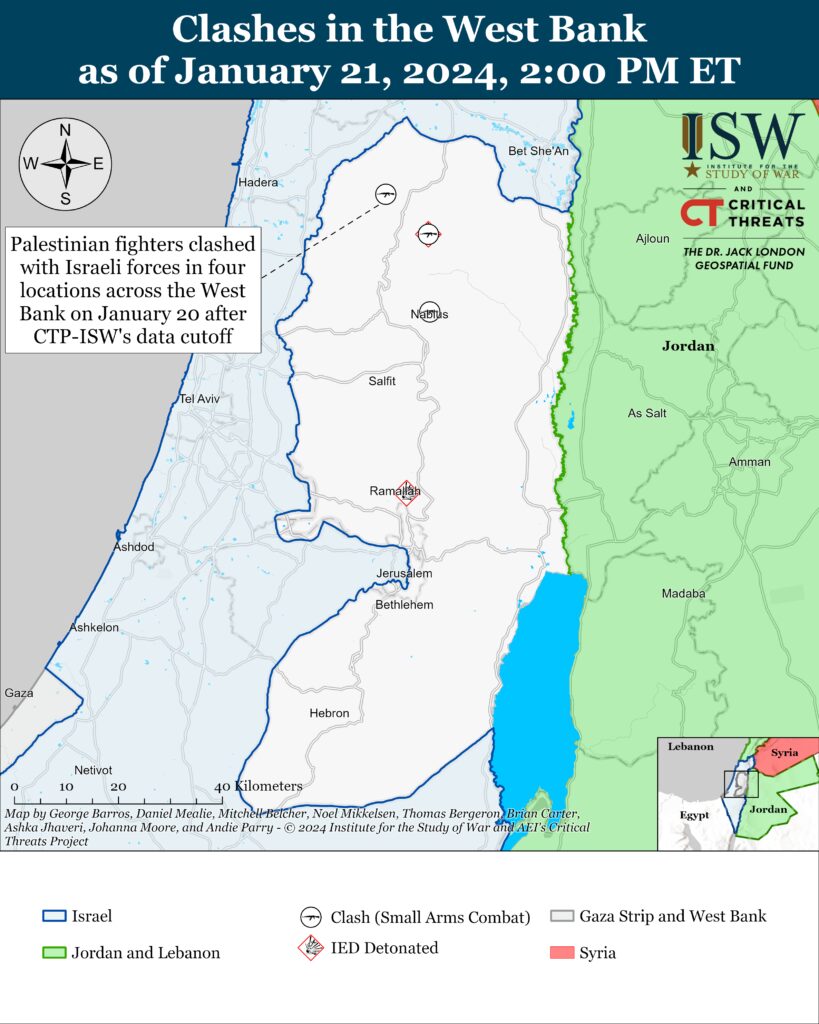
This map is not an exhaustive depiction of clashes and demonstrations in the West Bank.
Southern Lebanon and Golan Heights
Axis of Resistance campaign objectives:
Draw IDF assets and resources toward northern Israel and fix them there
Set conditions for successive campaigns into northern IsraelLebanese Hezbollah (LH) conducted four attacks from southern Lebanon into northern Israel targeting Israeli towns and military facilities on January 21.[xxiv] LH said it fired rockets at a civilian area in retaliation for an Israeli strike in southern Lebanon that unsuccessfully targeted a senior LH field commander.[xxv]
The Islamic Resistance in Iraq—a coalition of Iranian-backed Iraqi militias—claimed responsibility for a drone attack targeting an unspecified Israeli military site in the Golan Heights.[xxvi] The group said that the attack occurred on January 20.

Recorded reports of attacks; CTP-ISW cannot independently verify impact.
Iran and Axis of Resistance
Axis of Resistance campaign objectives:
Demonstrate the capability and willingness of Iran and the Axis of Resistance to escalate against the United States and Israel on multiple fronts
Set conditions to fight a regional war on multiple frontsThe Islamic Resistance in Iraq claimed responsibility for two one-way drone attacks targeting US positions in Syria on January 21.[xxvii] The group claimed a one-way drone attack targeting US forces stationed at al Shaddadi in Hasakah Province and US forces stationed at al Omar oil field in Deir ez Zor Province.

